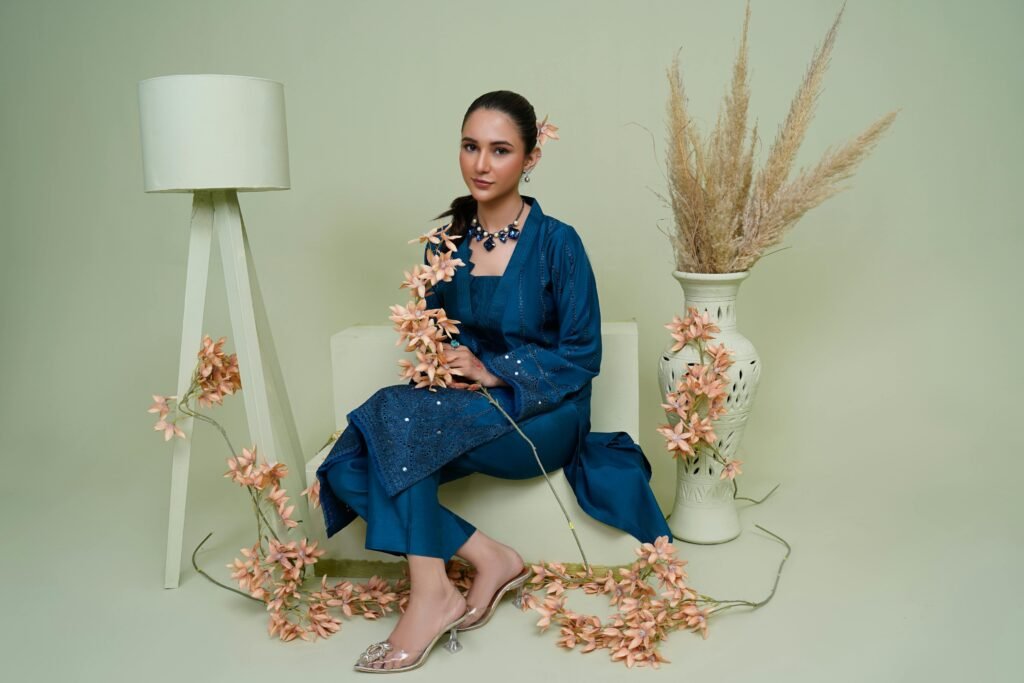Pakistani traditional ladies’ suits have long been admired for their elegance, versatility, and cultural richness. Worn by women across the country and loved worldwide, these outfits reflect a blend of tradition, art, and evolving fashion. From daily wear to festive ensembles, traditional suits hold a special place in the wardrobe of every Pakistani woman.
Overview of Pakistani Traditional Attire
Pakistani traditional attire for women primarily consists of three pieces:
- Kameez (tunic or shirt)
- Shalwar or trousers (bottom wear)
- Dupatta (long scarf or shawl)
The beauty of these suits lies in their adaptability to various regions, styles, and occasions. Whether it’s the vibrant clothes of Punjab or the intricate embroidery of Sindh, every region brings its charm to the traditional suit.

Popular Styles of Traditional Suits
a. Shalwar Kameez
The most classic and widely worn style. It consists of a straight-cut kameez with a comfortable shalwar. Depending on the fabric and embellishment, this outfit is suitable for casual, formal, and semi-formal occasions.
b. Anarkali Suit
Named after the legendary courtesan Anarkali, this style features a long, frock-style kameez with a fitted bodice and flared skirt. It’s a popular choice for weddings and festive events.
c. Churidar Suit
This includes a tight-fitting churidar (tapered pants) paired with a long or mid-length kameez. The sleek silhouette of this style gives a graceful look and is often worn at formal gatherings.
d. Angrakha Style
A traditional Mughal-inspired design, the angrakha features a cross-over bodice with decorative ties and a flared bottom. It has a regal look and is often adorned with intricate embroidery.
Fabrics and Embellishments
Pakistani suits are made in a wide variety of fabrics, including:
- Cotton: Ideal for daily wear, especially in summer.
- Lawn: A soft, lightweight cotton blend popular for its breathable quality.
- Silk, Chiffon, and Net: Often used for formal wear due to their luxurious appearance.
Embellishments play a key role in enhancing the look of a traditional suit. Common embellishments include:
- Embroidery (thread work, zardozi, mirror work)
- Sequins and beadwork
- Lace and gota detailing
Cultural Significance
Traditional suits are more than just garments—they are expressions of cultural identity and heritage. They are worn at major life events like weddings, Eid celebrations, and family functions. The colors, styles, and motifs often hold symbolic meanings rooted in regional and cultural traditions.
Modern Trends and Fusion Styles
While traditional designs remain timeless, modern fashion has introduced fusion styles that blend Eastern and Western elements:
- Cape-style kameez
- Jacket suits
- Pant-style trousers with short kurtis
These modern touches allow younger generations to stay connected with their roots while embracing contemporary fashion.
Conclusion
Pakistani traditional ladies’ suits continue to evolve with time, maintaining their cultural essence while adapting to changing trends. Whether worn casually or on special occasions, these outfits symbolize grace, beauty, and cultural pride. Their timeless charm ensures they remain essential to every Pakistani woman’s wardrobe.

